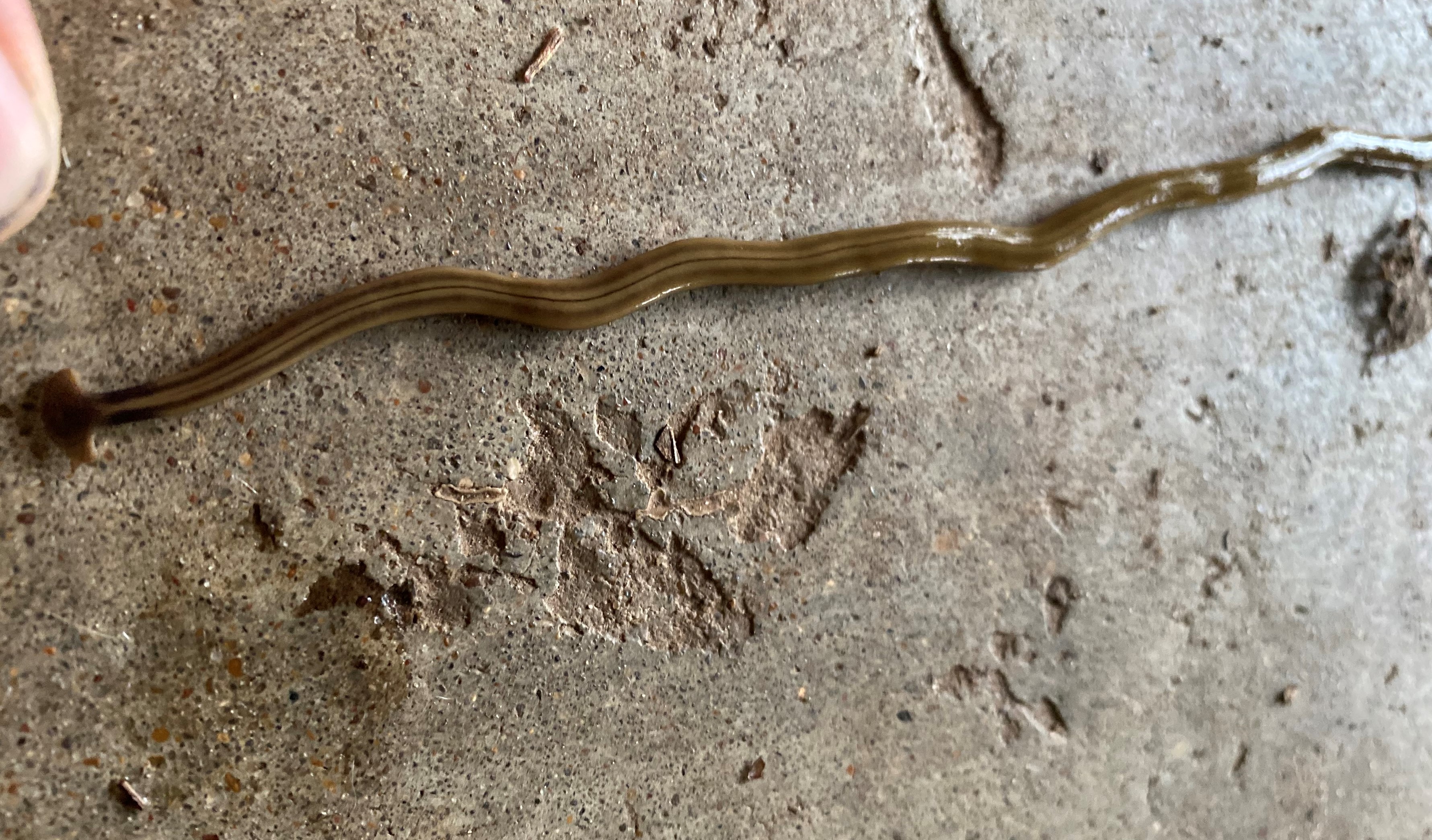
C. Neff,
Texas Invasives citizen report
Class: Turbellaria
Order: Tricladida
Family: Geoplanidae
Synonym(s):
Description: The common name fore this pest is very accurate as the head is shaped like a hammerhead shark, but rounded. Bipalium kewense is a terrestrial flatworm with a half-moon shaped head. It is typically light/honey colored, with 1 to 5 dark dorsal stripes (median stripes are thin), and a dark collar that is incomplete in this species (complete dark collar could be B. vagum). The body is snake-like being up to 15 inches long (usually 8-12 inches) and very narrow..
History: Apparently brought to the U.S. with horticultural plants; it has been regularly found in greenhouses since 1901 (Esser 1981). They were reported as being so plentiful in New Orleans that they were used as demonstration material in zoology classes (Dundee and Dundee 1963)
Biology: Like all Bipalium that have been studied, this species of hammerhead flatworm is hermaphroditic. Sexual reproduction has not been observed but egg cases have been found which suggests external fertilization could occur. For temperate regions, reproduction seems to be primarily achieved through fragmentation: a small rear portion of the worm will pinch off, and "stay behind" as the worm moves forward. Within about 10 days, the head begins to form. If you see one, be sure to dispose of the whole creature.
Ecological Threat: Known predator of earthworms that are necessary for the health of our forests, crops, gardens and compost piles. Bipalium& species secrete chemicals through their skin to make themselves noxious to predators, and aid in the digestion of earthworms. These chemicals can cause skin irritation on humans if they hold the flatworm, and domestic mammals if they consume the flatworm. Furthermore, many flatworms can carry parasitic nematodes within them. All of these reasons are why we encourage safe practices and disposal
US Habitat: Prefers hot, humid environments, so it does well in greenhouses; in tropical and subtropical areas it can spread from greenhouses. During the day hammerhead flatworms spend their time under leaf litter, rocks and logs and such, and under shrubs, out of the sun; under dripping garden faucets. They may be found out on the soil, driveways, patios, sidewalks after heavy rains. Feed and move about during the night. (Choate and Dunn 2012)
Distribution
Native Origin: Southeast Asia (Winsor 1983)
US States: Natural habitats: CA, FL, GA, LA,MS, NC, SC, TX. (Possible temporary populations: AZ, MA, NH)
Greenhouses: AL, CA, GA, IL, KY, MA, MI, NC, NJ, NY, OH, OK, SC, TN
Resembles/Alternatives: No native species. There are other invasive Bipalium hammerhead flatworms appearing in Texas including Bipalium vagum from the Houston and Austin areas, and it poses the same threats to earthworms.
Management: B. kewense can be killed with orange essence (citrus oil), and salt (as with slugs and snails). They can also be sprayed with a combination of citrus oil and vinegar; or just 30 percent concentrate vinegar alone and it must be directly applied. One can keep a spray bottle of concentrate vinegar while gardening and spray flatworms as they go. If you are removing the flatworm, placing them in a seal-able container (bag or jar) to ensure the flatworm does not crawl away after treatment; then dispose of it in the trash.
** When handling live flatworms please use gloves, paper towel or a stick. Hands should be washed with warm soapy water then standard hand disinfectant.**
Text References
dixxie (2014) in Internet Brands. 2014. Detailed information on Hammerhead Worm (land planarian) (Bipalium kewense)”. http://davesgarden.com/guides/bf/go/1839/#b. (Scroll down to dixxie’s entry.) [Accessed Dec 8 2014]
Internet Brands. 2014. “Detailed information on Hammerhead Worm (land planarian) (Bipalium kewense)”. http://davesgarden.com/guides/bf/go/1839/#b. [Accessed Dec 8 2014]
Paul M. Choate, and R. A. Dunn. 1998, revised 2012. Land planarians - Bipalium kewense Mosely and Dolichoplana Moseley.
University of Florida (Institute of Food and Agricultural Sciences). http://entnemdept.ufl.edu/creatures/misc/land_planarians.htm. [Accessed Dec 8 2014]
Data Source
Esser, R. P. 1981. Land Planarians (Tricladida: Terricola). Contribution no. 227, Bureau of Nematology, Florida Department of Agricultural and Consumer Services, Division of Plant Industry, Gainesville, Fl.
Ducey, P. K., Cerqua, J., West, L. J., and Warner, M. 2006. Eberle, Mark E., ed. Rare egg capsule production in the invasive terrestrial planarian Bipalium kewense;The Southwestern Naturalist</i> 51 (2): 252. doi:10.1894/0038-4909(2006)51[252:RECPIT]2.0.CO;2
Dundee DS, Dundee HA. 1963. Observations on the land planarian Bipalium kewense Moseley in the Gulf Coast. Systematic Zoology 12: 36-37.
Winsor, L. 1983. A revision of the cosmopolitan land planarian Bipalium kewense Moseley, 1878 (Turbellaria: Tricladida: Terricola). Zool. J. of the Linnean Soc.79: 61-100.
Last Updated: 2024-02-13 by Ashley Morgan-Olvera, TISI